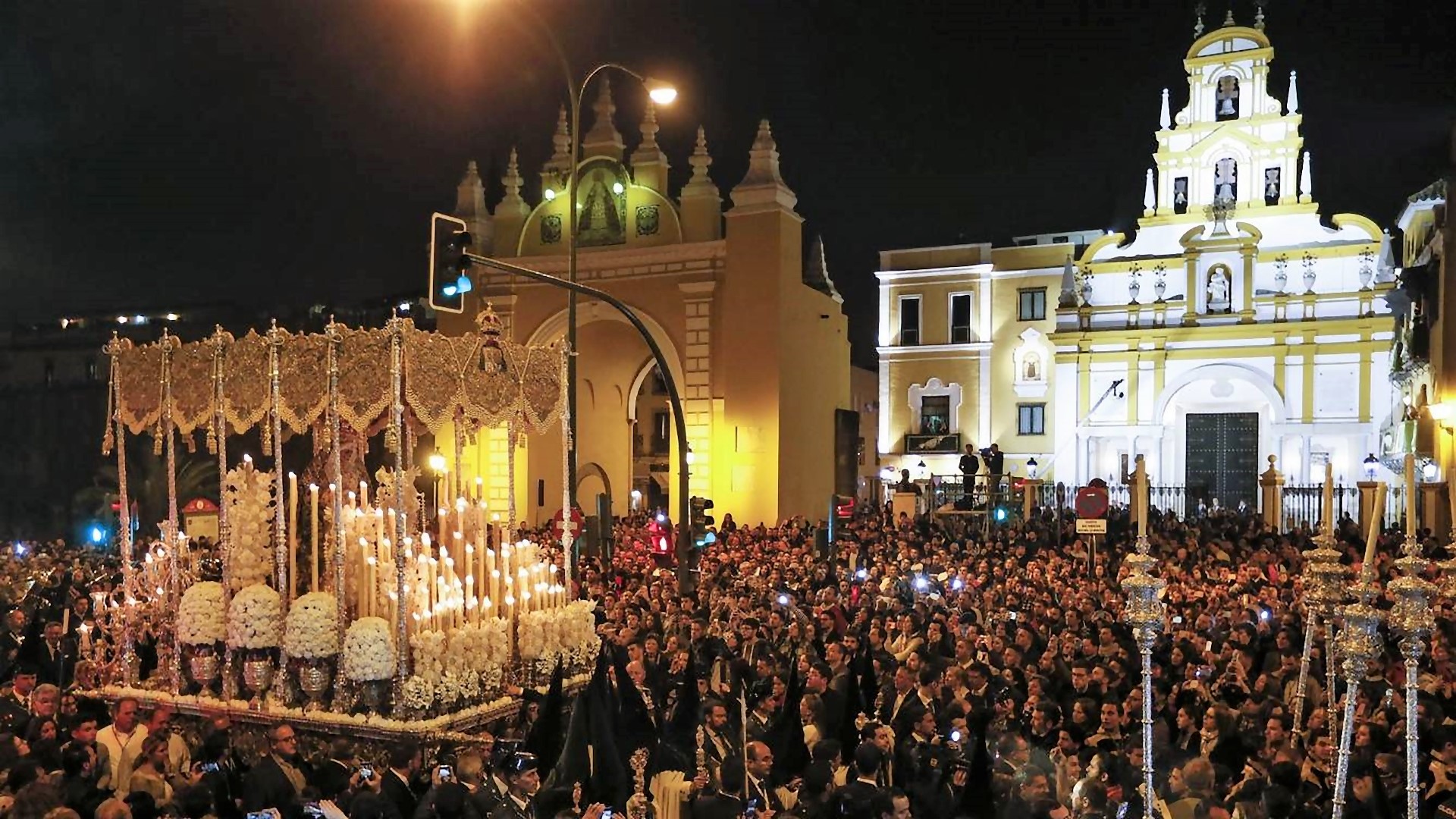Easter Processions
The Easter Week processions: from Palm Sunday to the glory of the Resurrection.
Upon arriving in Andalusia in EasterWeek, the best thing is to let your senses seduce you: breath in the subtle aroma that impregnates the environment, a mixture of incense and orange blossom; feel the emotion of a heartfelt saeta (religious flamenco song) and listen to the silence of a devout crowd…
Over these seven days, Andalusia is transformed as the local people go out to celebrate Easter Week. You will discover images of great artistic worth, paraded through the streets under the warm light of candles, the colour of the Nazarenes’ tunics and the music of bands with drums and trumpets. All this combined with the mixture of incense and orange blossom aroma brings out the magic and awakens a feeling of privilege in all those in attendance.
To feel the emotion of the traditional, crowded “madrugá” Seville; live the passion with the Málaga, “El Cautivo”; follow in the footsteps of the Cristo de Los Gitanos (Gipsy Christ) Sacromonte neighbourhood in Granada; witness the solemnity of Good Friday with the “Santo Encierro” in Huelva; see the “El Abuelo” procession head out in the early hours of Good Friday from the cathedral in Jaén; feel the passion and commitment of the Easter brotherhoods in Cádiz; explore the streets of Córdoba amidst silence, the sound of a saeta (religious flamenco song), the sound of the bells of the capataz (procession leader)… and bear witness to the coming together of the brotherhoods in Almería… Are you going to miss all this?
An atmosphere of mourning and devotion is succeeded by a day full of light and colour and the sound of bells pealing from the gables and towers of our cathedrals, churches and hermitages.
From South to North, from the world known Seville´s Semana Santa, the one in Malaga and in Granada as the most representatives in the south of Spain, we will also recommend you to visit the Processions in Old Castile, northern Madrid, in which some of the most popular ones, are the ones in Valladolid and Zamora.
Also, we can not forget to mention the Rocio Pilgrimage which happens near Seville every year and the Corpus Christi in Toledo, near Madrid.
No matter v in which part of Spain you attend an Easter Week procession, and even if you are not catholic, you will come away with the sensation that you have experienced something truly unique. It should not be surprising to discover then that many processions have been declared of international interest from around the world.
In both Castile and Andalusia, exquisite wooden sculptures of religious figures from the most ancient to the most modern are brought out from their enclaves to be admired and adored during the procession through the streets.
But, while the sculptures themselves are well-worth seeing, there are occasional pauses in the processions during which a song, saeta, is sung by one of the faithful from a balcony.
Equally beautiful and profound as the famous processions of Seville, are those in Granada, Jerez, Ronda, Cadiz or Malaga in Andalusia or the ones in Zamora, Valladolid, Burgos, Toledo or Madrid in central Spain.
We have to samples of itineraries for your group if is interested. One is the Easter Week in Andalusia ( Seville, Cadiz, Ronda, Granada and Malaga). The other is Easter Week in Castile ( Zamora, Salamanca, Valladolid, Segovia, Toledo & Madrid).
Two different tour programs of 8 days during your next Easter vacation in Spain.
Contact us!
-
Destination
TOUR LOCATION
Andalusian Easter Processions are the annual Christian commemoration of the Passion, Death and Resurrection of Jesus of Nazareth and one of the most genuine expressions of Andalusian Christian feeling.
Upon arriving in Andalusia in EasterWeek, the best thing is to let your senses seduce you: breath in the subtle aroma that impregnates the environment, a mixture of incense and orange blossom; feel the emotion of a heartfelt saeta (religious flamenco song) and listen to the silence of a devout crowd… Over these seven days, Andalusia is transformed as the local people go out to celebrate Easter Week. You will discover images of great artistic worth, paraded through the streets under the warm light of candles, the colour of the Nazarenes’ tunics and the music of bands with drums and trumpets. All this combined with the mixture of incense and orange blossom aroma brings out the magic and awakens a feeling of privilege in all those in attendance. To feel the emotion of the traditional, crowded "madrugá” Seville; live the passion with the Málaga, "El Cautivo”; follow in the footsteps of the Cristo de Los Gitanos (Gipsy Christ) Sacromonte neighbourhood in Granada; witness the solemnity of Good Friday with the "Santo Encierro” in Huelva; see the "El Abuelo” procession head out in the early hours of Good Friday from the cathedral in Jaén; feel the passion and commitment of the Easter brotherhoods in Cádiz; explore the streets of Córdoba amidst silence, the sound of a saeta (religious flamenco song), the sound of the bells of the capataz (procession leader)... and bear witness to the coming together of the brotherhoods in Almería... Are you going to miss all this?Andalusian Easter Processions are the annual Christian commemoration of the Passion, Death and Resurrection of Jesus of Nazareth and one of the most genuine expressions of Andalusian Christian feeling.
Seville
Andalusia celebrates its festivals with passion and abandonment. Seville, as the region’s capital, hosts some of the most important events. When the orange trees begin to blossom, Seville decks itself out for its famous Semana Santa (Easter Week) and Feria de Abril (April Fair). The city’s most famous celebration, Semana Santa was begun in the 14th century. In the 17th century, it assumed the traits which it maintains today, coinciding with the golden age of Sevillian religious images. This is the period of the creation of Jesús del Gran Poder, La Macarena, and the Christ of Cachorro, pivotal images of the processions. Semana Santa in Seville spans the 7 days of Easter, with the staging of daily processions, as well as the 40 days of Lent, necessary for the preparations. The celebration lasts from Palm Sunday to Easter day and includes the participation of 57 brotherhoods.Malaga
The Easter Week, a very solemn event in the capital which dates from the 15th century – the beautiful stages of the Passion of Christ (wooden figures by Pedro de Mena and Benlliure, among others) and the baroque ornamentation of the processional ‘thrones’ make it one of the most attractive Easter weeks in Spain.Granada
Holy Week has been officially declared a “Holiday of Interest to the Tourist” and is one of Granada’s best festivities, attracting more and more visitors each year with increasing displays of popular fervour. On Wednesday of Holy Week, there is a procession held called “Christ of the Gypsies” or “Christ of Sacromonte”. Other processions of interest are: the Procession of Silence held at midnight on Thursday of Holy Week, departing from the Church of San Pedro on the Carrera del Darro, and Procession of Las Angustias on Saturday of Holy Week. Other religious festivals in Granada:- May 3rd is the Festival of Crosses, a very popular celebration. Crosses made of flowers are placed in the streets, while courtyards of the houses are also adorned.
- Between May and June, the Corpus Christi Fair, the biggest festival in the city, is celebrated. The typical Andalusian dress is worn, horse-drawn carriages are used, and there is dancing at the stalls of the fair. Bullfights are also held.
- The last Sunday in September is the Festival of the Virgen de las Angustias, patron saint of the city. Open-air dances, bullfights and processions are held.







